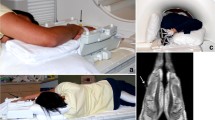Similar content being viewed by others
References
Emery P (1994) The optimal management of early rheumatoid disease: the key to preventing disability. Br J Rheumatol 33: 765–768
American College of Rheumatology Extremity Magnetic Resonance Imaging Task Force (2006) Extremity magnetic resonance imaging in rheumatoid arthritis: report of the American College of Rheumatology Extremity Magnetic Resonance Imaging Task Force. Arthritis Rheum 54: 1034–1047
Wakefield RJ et al. (2004) Should oligoarthritis be reclassified? Ultrasound reveals a high prevalence of subclinical disease. Ann Rheum Dis 63: 382–385
Klauser A et al. (2005) Contrast enhanced gray-scale sonography in assessment of joint vascularity in rheumatoid arthritis: results from the IACUS study group. Eur Radiol 15: 2404–2410
Wakefield RJ et al. (2000) The value of sonography in the detection of bone erosions in patients with rheumatoid arthritis: a comparison with conventional radiography. Arthritis Rheum 43: 2762–2770
McQueen FM et al. (2003) Bone edema scored on magnetic resonance imaging scans of the dominant carpus at presentation predicts radiographic joint damage of the hands and feet six years later in patients with rheumatoid arthritis. Arthritis Rheum 48: 1814–1827
Ostergaard M et al. (2003) New radiographic bone erosions in the wrists of patients with rheumatoid arthritis are detectable with magnetic resonance imaging a median of two years earlier. Arthritis Rheum 48: 2128–2131
Conaghan PG et al. (2003) Elucidation of the relationship between synovitis and bone damage: a randomized magnetic resonance imaging study of individual joints in patients with early rheumatoid arthritis. Arthritis Rheum 48: 64–71
Karim Z et al. (2004) Validation and reproducibility of ultrasonography in the detection of synovitis in the knee: a comparison with arthroscopy and clinical examination. Arthritis Rheum 50: 387–394
Ostergaard M et al. (1997) Magnetic resonance imaging-determined synovial membrane and joint effusion volumes in rheumatoid arthritis and osteoarthritis: comparison with the macroscopic and microscopic appearance of the synovium. Arthritis Rheum 40: 1856–1867
Wakefield R et al. (2006) Anti-TNF induced remission in very early RA: A longitudinal study of imaging and clinical remission. Rheumatology 45 (Suppl 1): i50
Brown A et al.: RA patients in DMARD induced clinical remission still have significant synovitis: evidence from an imaging study may explain structural progression. Arthritis Rheum, in press
Author information
Authors and Affiliations
Corresponding author
Ethics declarations
Competing interests
The authors declared no competing interests.
Rights and permissions
About this article
Cite this article
Freeston, J., Emery, P. The future of imaging in monitoring biologic therapy. Nat Rev Rheumatol 3, 2–3 (2007). https://doi.org/10.1038/ncprheum0381
Received:
Accepted:
Issue Date:
DOI: https://doi.org/10.1038/ncprheum0381
- Springer Nature Limited





